
Posts Tagged: leafcutting bees
Bed Check!
All winter long my bee condo housed 16 tenants...and one earwig. And quite comfortably, too, thank...

Newly emerged leafcutter bee outside her nest. (Photo by Kathy Keatley Garvey)
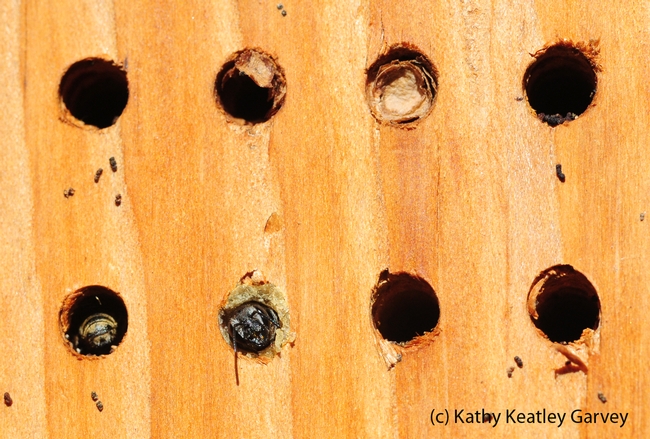
One leafcutter bee is tucked in head first; the other is ready to leave. (Photo by Kathy Keatley Garvey)
Snug as a Bug in a...Bee Condo
When you try to attract leafcutting bees (Megachile spp.) to your bee condos, you may also attract...
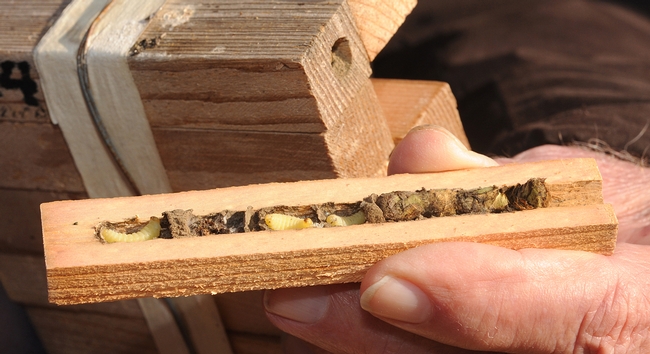
Bee condo for leafcutting bees includes the offspring (left) of a solitary mason wasp. (Photo by Kathy Keatley Garvey)

Leafcutting bee (left) emerges from her hole in a photo taken last summer. At right a plugged hole. (Photo by Kathy Keatley Garvey)

Leafcutting bee sealing her nest in a photo taken last summer. (Photo by Kathy Keatley Garvey)
Home Invasion!
When you install bee condos--those wooden blocks with holes drilled in them to attract nesting...
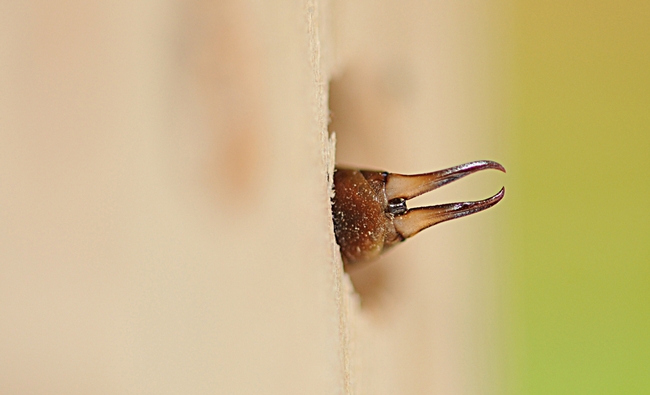
Earwig inside a blue orchard bee condo, which has larger holes than one for leafcutting bees. (Photo by Kathy Keatley Garvey)
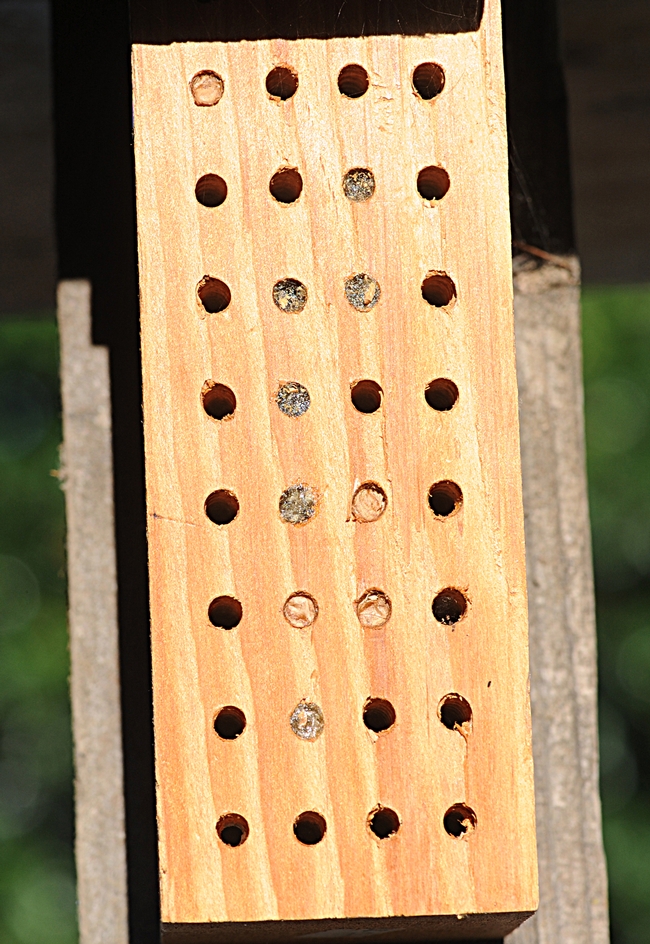
This bee condo for leafcutting bees has 10 tenants. It is about the size of a brick and has smaller holes than a bee block for blue orchard bees. (Photo by Kathy Keatley Garvey)
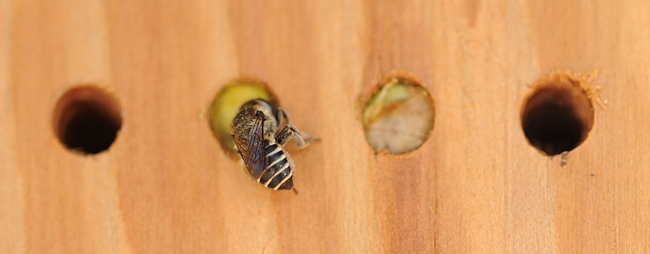
Leafcutting bee provisioning her nest. (Photo by Kathy Keatley Garvey)
These bees 'cut it'
We're in the midst of a housing crisis, so why not build a 30-unit, high-rise condo in your yard?
No, not for people--for native bees.
We just installed a bee condo for leafcutting bees (Megachile spp.), on a five-foot high pole overlooking catmint, lavender and salvia. The "housing development" is actually a wooden board drilled with small holes to accommodate our tiny tenants. Comfy and convenient. Rooms with a view. No housing permits or EIR required. Rent-free, mortgage-free.
Leafcutting bees, aka leafcutter bees, are about the size of a honey bee but darker, with the characteristic light-banded abdomens. They are important pollinators.
Why are they called leafcutter bees? Because the females cut leaf fragments to construct their nests to raise their brood. In nature, they build their nests in soft, rotted wood or in the pithy stems of such plants as roses, raspberries, sumac and elderberry.
Unlike honey bees, which are social, the leafcutting bee is a solitary nesting bee. She provisions her leaf-lined nest with nectar and pollen, lays an egg, and seals the cell before leaving.
Commercially made bee condos are available at beekeeping supply stores or on the Internet. You can make or buy a board with different sized-holes so other native bees, such as blue orchard bees, aka mason bees, receive a "home, sweet home," too, and deliver pollinator services.
And enable you to tell your family and friends that you're a "bee landlord" or beekeeper.
The Xerces Society for Invertebrate Conservation offers tips on building bee condos on its website and in its publications, including Farming for Bees: Guidelines for Providing Native Bee Habitat on Farms.
If you don't want bee boards housing your tenants, you can provide straws or hollow bamboo stems.
At the UC Davis Department of Entomology, doctoral candidate Emily Bzdyk is doing research on leafcutter bees. "Basically I'm doing a revision of the subgenus Litomegachile, part of the large genus Megachile, which includes leafcutter and resin bees," she said. "They are native to North America. My goals are to find out how many and what the species are in Litomegachile, and find out as much as I can about their biology, or how they make a living."
"I also want to identify clearly what the boundaries between the species are, or how to tell them apart from one another," said Bzdyk, whose major professor is Lynn Kimsey, director of the Bohart Museum of Entomology. "Litomegachile are very common and hard-to-identify to species, and I feel they deserve attention."
Bzdyk noted that some Megachile are used in commercial alfalfa production. The alfalfa leafcutter bee, native to Europe, is used for commercial pollination of alfalfa, she said. "The Litomegachile is probably very closely related."
The alfalfa growers erect giant bee condos in their fields to draw bees to their plants.
With home gardeners, the effect is the same.
If you build them, they will come.
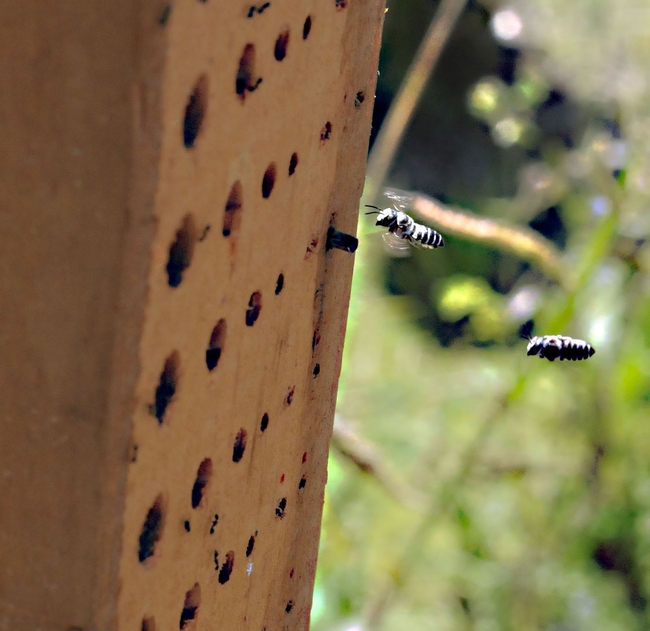
Leafcutting bees, aka leafcutter bees (genus Megachile) head toward a bee condo built for these and other pollinators. (Photo by Kathy Keatley Garvey)
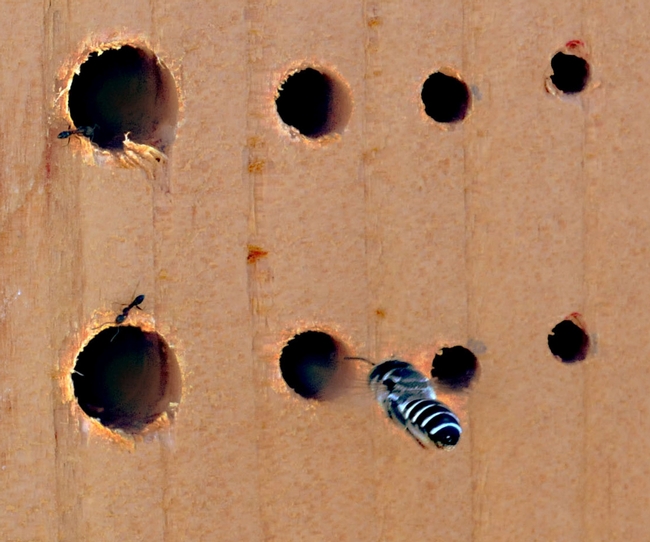
Home sweet home: Oblivious to ants, a leafcutter bee heads for home. (Photo by Kathy Keatley Garvey)
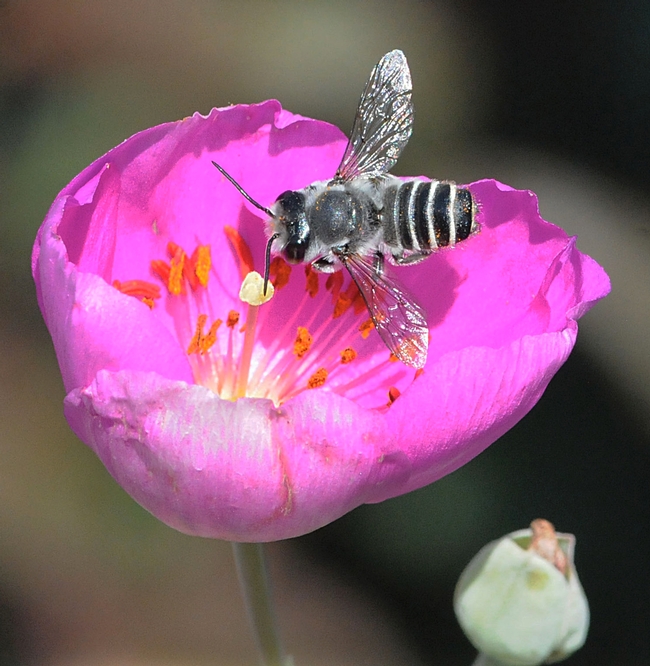
Male leafcutter bee (genus Megachile) sips nectar from a rock purslane. (Photo by Kathy Keatley Garvey)
